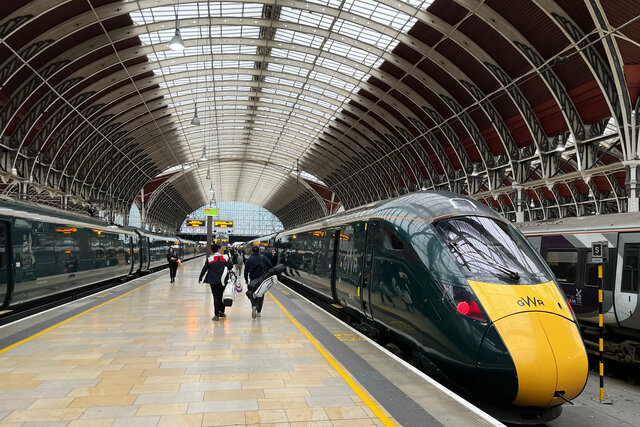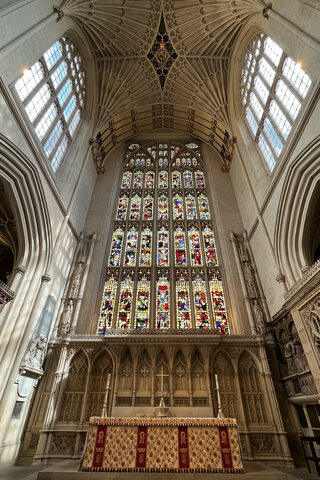Bath Spa
Started: 2023-04-18 19:22:06
Submitted: 2023-04-18 20:59:33
Visibility: World-readable
Taking the Great Western Main Line to Bath to see the Roman hot springs
The fire alarm went off in our flat in the middle of the night in the early morning hours of Thursday, 6th April. By the time I got out of bed and checked on the kids in the next room (and confirmed that I did not see any obvious signs of fire or smoke myself) the alarm went off and stayed off. Kiesa stuck her head out the door and the reception desk told her it was a flat upstairs.
Our plan for the day was to take a day-trip to Bath. To get to Bath we had to take a train from Paddington, which meant we had to leave the flat by 08:15 to get there in time. This was a lot to ask from my family, who might have been awake but would have preferred to stay in their beds with their screens. (We took the circle line clockwise from South Kensington to Paddington.) At the station I bought our train tickets (which turned out to be on the last morning peak service so I paid considerably more than a train departing a half-hour later; I think I could have saved money by buying a timed ticket in advance but it wasn't obvious that I needed to do so) while Kiesa searched the station in search of croissants and coffee for breakfast. We boarded our train (a dual-fuel class 800 multiple unit, operating on electric power closer to London then switching to diesel power when the overhead pantograph ran out) and found a group of four seats surrounding a table.
The journey to Bath-Spa took one hour, twenty minutes along the Great Western Main Line, traveling 107 miles at a maximum speed of 125 miles per hour. When we reached Chippenham the train switched to diesel traction; I felt the purr of the diesel engine beneath my feet as the train accelerated out of the station.
We arrived in Bath in time for our 10:45 timed tickets at the Roman Baths in the center of town. (Most of the later slots were already reserved by people who presumably wanted to take later, non-peak trains out of London.)
We picked up audio guides and stepped through the Georgian entry building to the deck overlooking the original baths. Everything above the columns had been reconstructed in the nineteenth century, but the pool was original, two thousand years old from the time when the Roman Empire stretched all the way to Britain.
The one-way tour took us around the upper level of the main pool, past a number of artifacts recovered from the site, and down to the original ground level, where we walked on a walkway suspended above the excavated paving stones that made up the site. (The interpretive material said that the blocks stacked in the foreground had been a temple.)
The audio guide was interesting and provided additional information about the site and the artifacts it described, but it took its time delivering its information, and it was narrated at a languid pace; as a result people crowded around the artifacts with their guides pressed to their ears, waiting to hear every drop of information before proceeding to the next stop. (I don't normally listen to podcasts or audiobooks at higher speed, but this audio guide probably would have benefited from a faster pace.)
The site's archeologists believe that the bath had been covered by an arched ceiling that would have protected the main pool from direct sunlight and kept it from growing the algae that tints the pool green today.
The ground level of the pool is below the current city of Bath. On the ground level the tour took us through a series of rooms featuring a series of cold and warm baths, heated floors, massage rooms, and sports rooms. At Roman baths elsewhere in the empire, the pools would have been heated by fires on the site, but in Bath the Romans took advantage of the local hot springs to heat their main pool. They still used fires to heat the floors (elevated above the piles of bricks that survive here) in their heated sauna.
In the ground surrounding the baths was an original Roman lead pipe carrying water into the main pool, built with a large seam on one side where the lead plate had curved around to attach to itself.
We exited via the gift shop and headed out into the town of Bath in search of lunch. On the way in I spotted a Cornish bakery where we found a selection of pastys. We ordered a selection and sat on a bench outside to eat lunch.
Our next stop was Bath Abbey, the only religious building we visited in the UK. (Unlike the Houses of Parliament, which looks superficially similar, this was actually built during the Gothic period.) This building featured one of the best surviving examples (along with the chapel at Trinity College in Cambridge) of the elaborate fan-like structure of the ceiling vault, the defining characteristic of perpendicular Gothic.
Standing under the long barrel vault running the length of the nave it was impossible to get a view point suitable to see the entire structure. It wrapped around me on every side, impressive even by my twenty-first-century mind.
One of the stained glass windows on the side of the altar depicted the coronation of Edgar in 973, the first king to be crowned as "King of All England". He was crowned king at an earlier monastery in Bath, near the site of the abbey I was standing in.
We stepped into the small museum in the basement, which presented the history of the abbey and the various waves of decay and restoration. (If I read the dates right, it was restored in the reign of Henry VIII then fell into disrepair again when he dissolved all of the monasteries.) The most recent renovation was to rebuild the floor, paved with gravestones, replacing the forced-air furnace with under-floor heating supplied from the drain of the Roman baths next door.
We exited via the gift shop, where Julian got a mug depicting the abbey and I got a book discussing Christian religious architecture.
It had rained while we were inside the abbey, and the pavement in front of the abbey had been transformed into a shallow pool. We headed to the Jane Austen Centre, a small museum presented with a fascinating earnest kitch, with staff dressed up as characters from Jane Austen novels. The museum highlighted Jane Austen's life in Bath, with a video trying to find where she had lived; not every address still existed. Towards the end there was a dress-up section; I dressed up in a Regency waist-coat and top-hat for a photo opportunity in the indoor garden. (One of the other guests at the museum was already dressed up ahead of her reservation for the attached tea room.)
The museum had a locked tea box used to protect the tea (a luxury good during the Regency); which I found amusing given how much tea I have in various storage containers in my house.
By the time we wrapped up the Jane Austen Centre we no longer had time to visit any other museums in town (presumably to the relief of the rest of my family), so we walked to the Royal Crescent, a picturesque row of perfect Georgian townhomes in a half-circle around a green. (It was hard to get a good picture of the Royal Crescent from the ground level on the street itself; the best pictures I've seen are clearly from aircraft above the green looking down.)
We walked down to the grass in front of the green (on the other side of ha-ha, the invisible drop used to keep sheep from the upper part of the lawn right in front of the houses), then headed back in the direction of the train station. Along the way we stumbled upon a tiny back garden with an open gate and a sign identifying it as a small garden restored to Georgian style of the late eighteenth century, with stark geometric patterns in the gravel walkways and hedges. (The signs had pictures of the excavation of the gardens to uncover the earlier planting beds that made up the garden.) The hedges were neatly trimmed but the rest of the garden didn't seem to be in bloom yet in early April.
It rained intermittently as we walked back to the train station. We picked up more pasties from the Cornish bakery for supper, then arrived at the train station in time to see that the half-hourly service to London was delayed by twenty minutes. The platform was crowded as various other trains destined for places other than London arrived, picking up some of the passengers waiting on the platform, then departing the station with the sound of a multi-cylinder engine revving and plume of diesel exhaust that I associate more with large trucks than passenger railcars. When the delayed train arrived I decided we might as well wait another ten minutes for a (hopefully) less crowded train. This proved to be a good idea when the next train to London-Paddington pulled up right on time (in a sudden downpour, as the rain poured off the edge of the canopy covering the platform right onto the approaching train) and we had very little trouble finding a table for four (though many of the seats showed up as reserved, even though no one sat in them for the entire journey to London).
I had a good time seeing Bath, but it turned out that we had made one of the classic travel mistakes: trying to see too many things with too little time off between them. The rest of my family decided to stay in the flat on Friday, leaving me to plan my own adventure.
I took more pictures in Bath: Photos on 2023-04-06.


















